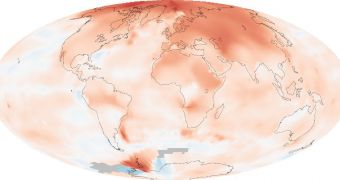A team of scientists led by experts at the Purdue University has determined that our planet recovered from past instances of global warming much faster than previously calculated. The discovery raises hope that the damage we caused in modern times could be mitigated in due time, if we act now.
Over its 4.5 billion years of existence, Earth has gone through numerous warming periods, during which rising carbon dioxide emissions boosted temperatures to levels much higher than today.
But the new analysis demonstrates that the planet was quick to recover from these instances, once it managed to get atmospheric CO2 concentrations in check. These conclusions were drawn from an in-depth analysis of such an event, which occurred 56 million years ago.
As the atmosphere began to heat up, and glaciers started to melt, experts say that ecological cycles were modified in such a way that massive amounts of CO2 began being extracted from the air.
This contributed to global cooling, and allowed temperatures to stabilize back to normal levels. Even with the new time frame, the world needed tens of thousands of years to recover. Previous estimates had placed the necessary time at hundreds of thousands of years.
The new study was led by Purdue associate professor of earth and atmospheric sciences Gabriel Bowen. He says that this “fast” recovery was not anticipated by any of the existing carbon cycle models, which demonstrates that we still have much to learn about this cycle.
“We found that more than half of the added carbon dioxide was pulled from the atmosphere within 30,000 to 40,000 years, which is one-third of the time span previously thought,” the expert explains.
“We still don’t know exactly where this carbon went, but the evidence suggests it was a much more dynamic response than traditional models represent,” adds Bowen, who also holds an appointment as a member of the Purdue Climate Change Research Center.
He and his team focused their attention of a period of global warming called the Palaeocene-Eocene Thermal Maximum, which is estimated to have lasted for about 170,000 years, Science Blog reports.
Bowen collaborated closely with University of California in Santa Cruz (UCSC) professor of earth and planetary sciences James Zachos for this research. The two say that the PETM was very similar to how the climate looks today.
“During this prehistoric event billions of tons of carbon was released into the ocean, atmosphere and biosphere, causing warming of about 5 degrees Celsius,. This is a good analog for the carbon being released from fossil fuels today, “Bowen concludes.

 14 DAY TRIAL //
14 DAY TRIAL //